Why you can trust Tom's Hardware
Benchmark Results
Our standard benchmarks and power tests are performed using the CPU’s stock frequencies (including any default boost/turbo), with all power-saving features enabled. We set optimized defaults in the BIOS and the memory by enabling the XMP profile. For this baseline testing, the Windows power scheme is set to Balanced (default) so the PC idles appropriately.
Synthetic Benchmarks
Synthetics provide a great way to determine how a board runs, as identical settings should produce similar performance results. Turbo boost wattage and advanced memory timings are places where motherboard makers can still optimize for either stability or performance, though, and those settings can impact some testing.




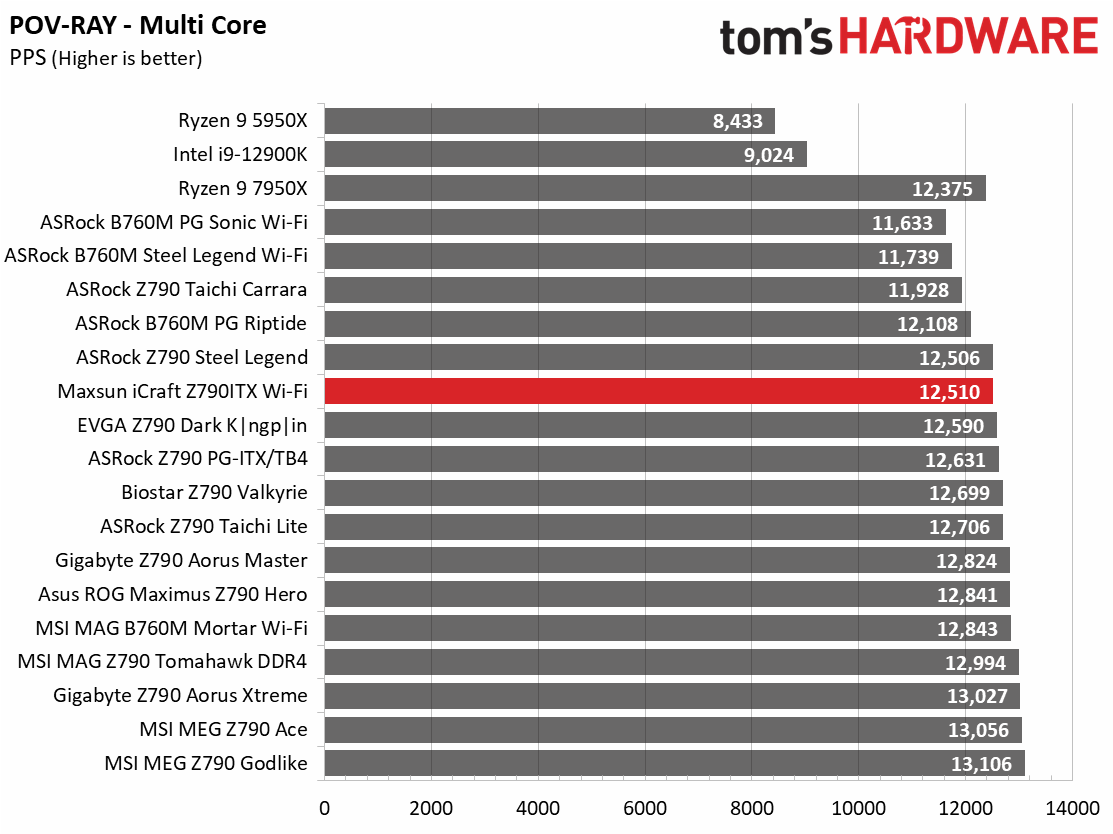






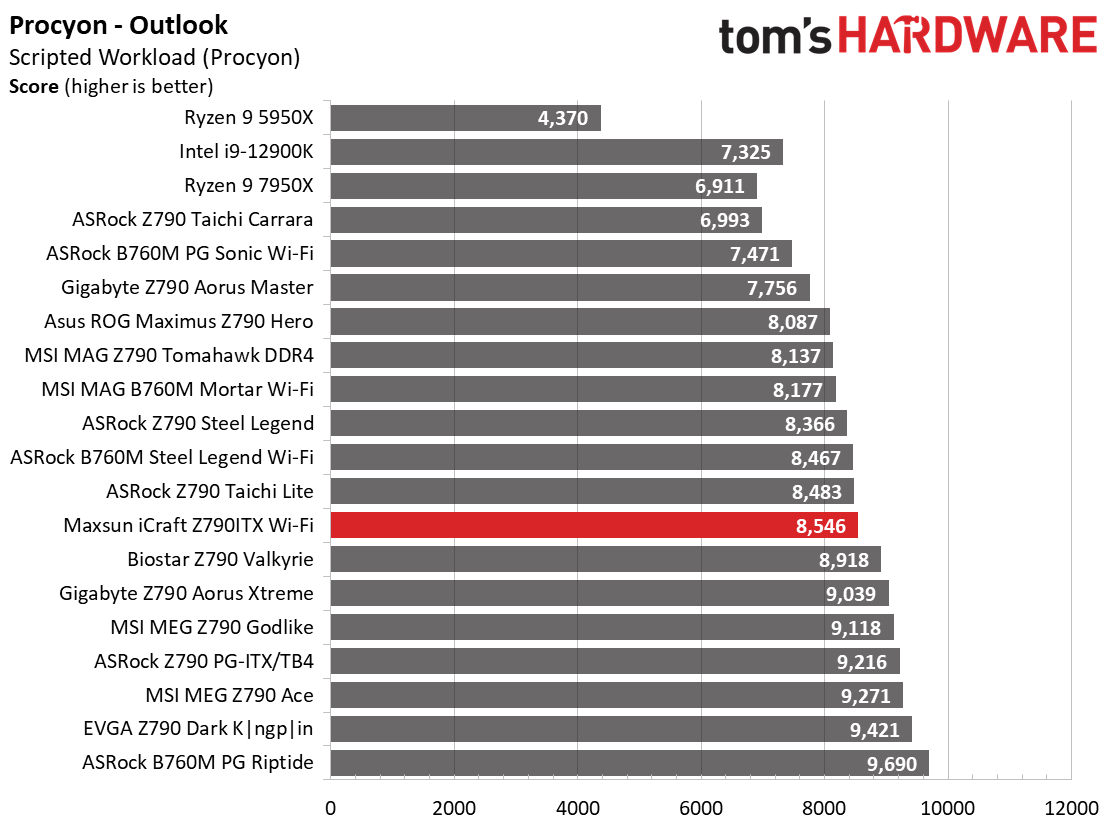



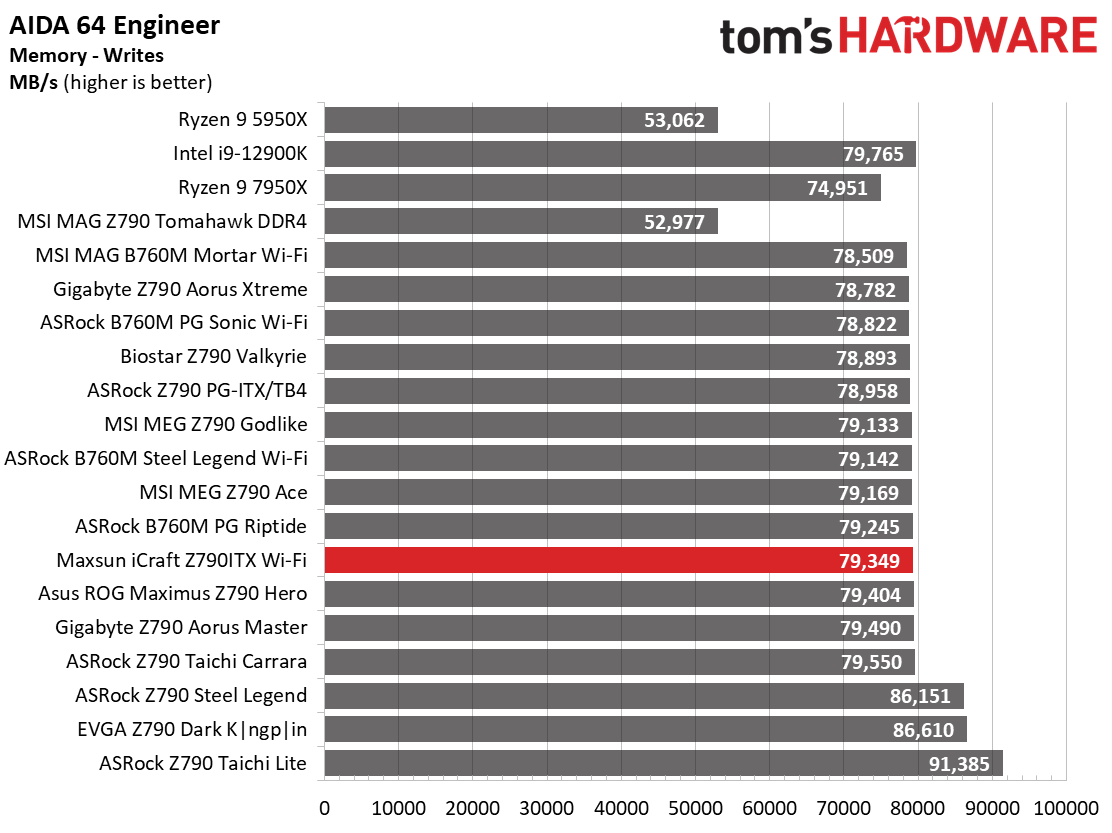
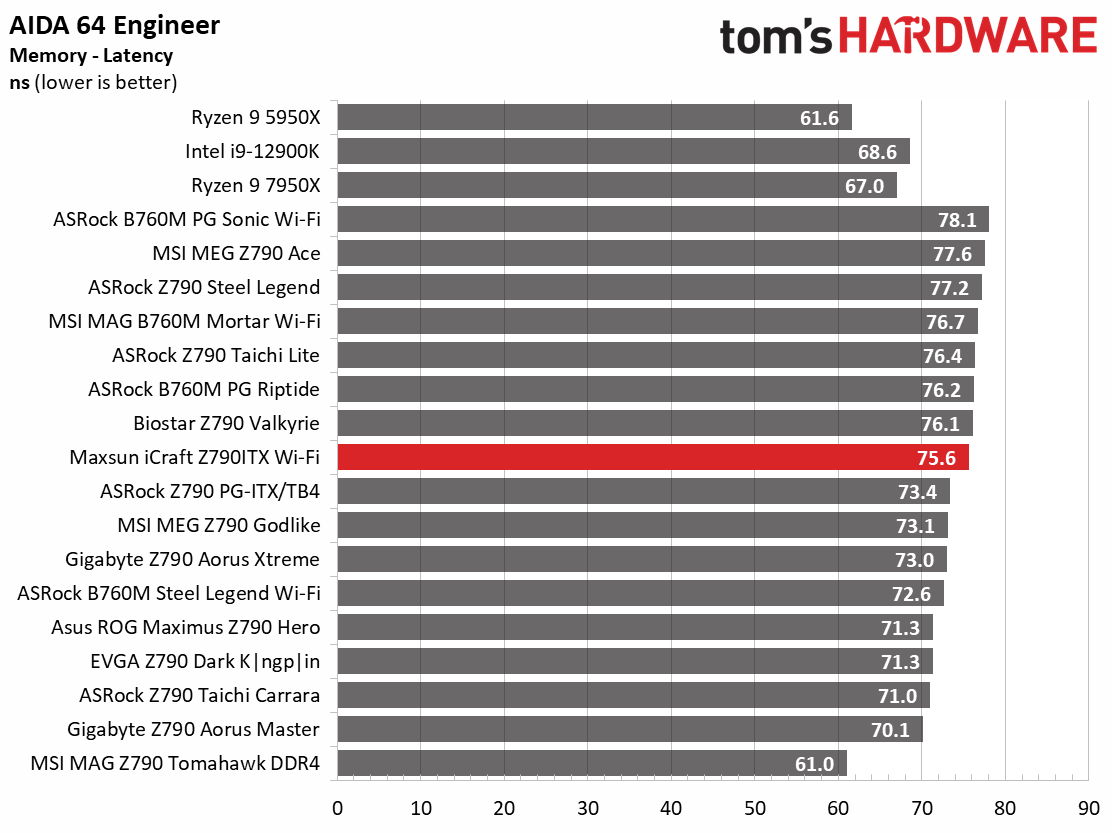

Across our synthetic benchmarks, the Maxsun board did well overall, with results hovering around average to above average, depending on the test. It did well in the Procyon Video and Photo editing tests, sitting at or near the top. Due to the default setting of PL1 at 241W (compared to Intel’s stock 125W), once the PL2 window closes, there isn’t much of a drop. In short, performance is limited to your cooling capability, as it’s simply banging off the temperature limit in some heavily threaded and longer-running tests.
Timed Applications




In our three timed applications (LAME, Corona and Handbrake), we saw average results. There’s nothing to worry about here, either.
3D Games and 3DMark


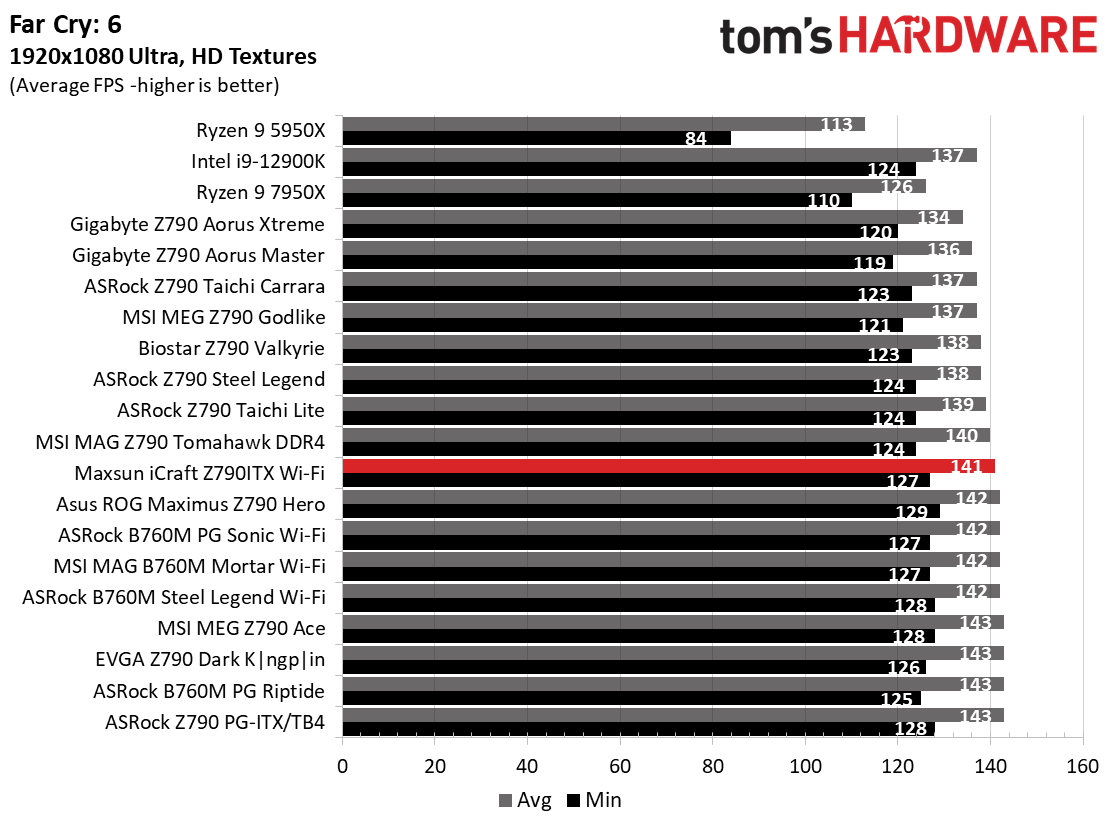

Starting with the launch of AMD’s Ryzen 7000 platform, we’ve updated one of our games, F1 21 to F1 22, while keeping Far Cry 6. We run the games at 1920x1080 resolution using the Ultra preset (details listed above). As the resolution goes up, the CPU tends to have less impact. The goal with these settings is to determine if there are differences in performance at the most commonly used (and CPU/system bound) resolution with settings most people use or strive for (Ultra). We expect the difference between boards in these tests to be minor, with most falling within the margin of error differences. We’ve also added a minimum FPS value, which can affect your gameplay and immersion experience.
The Maxsun Mini-ITX board is a capable gamer out of the box, offering middle-of-the-pack results in the game tests and the highest score we’ve seen in the 3DMark Timespy test. Overall, this board isn’t the fastest gamer we’ve seen, but you won’t notice a difference without running benchmarks, anyway. No worries here, either!
Overclocking
When overclocking, we aim to increase the power and add stress to the VRMs. We do so by increasing the clock speed and voltage until we’re at the thermal threshold for the processor during stress testing. However, where these CPUs are allowed to run with ‘boost’ speeds, those speeds are closer to the limit than ever before.
Get Tom's Hardware's best news and in-depth reviews, straight to your inbox.
With our Core i9-13900K, the approach was a bit different. We had to lower the voltage from what was recorded during stress tests to overclock our chip. We increased the clock speeds of the “P” and “E” cores by 100 and 200 MHz, respectively, over the turbo boost and limited by our cooling. We ended up with 5.6 GHz P core and 4.5 GHz E core clocks using about 1.34V (from DMM). Temperatures peak at or just under the throttling point with this configuration. And as we’ve noted elsewhere, this is the intended performance for Intel’s flagship CPU.
Overclocking with the Z790ITX Wi-Fi wasn’t too different than with other boards. The options are a bit basic, but still include the right ones to get the most out of your system. That said, we had some trouble dialing our system in using manual settings. But the auto settings worked. Again, we ran into thermal throttling during the stress test (pictured), but the board was able to keep the clocks in less stressful situations.
On the memory side, I dropped our Kingston Fury Beast DDR5-6000 kit in the system and then the Teamgroup DDR5-7200 kit. We enabled XMP and tested it without issue. While you may not be able to reach the heights for clocking memory that some Mini-ITX boards have (MSI’s, for example), it’s still well past the sweet spot and into the realm of fast just to be fast.
Power Consumption / VRM Temperatures
We used AIDA64’s System Stability Test with Stress CPU, FPU, Cache and Memory enabled for power testing, using the peak power cion value. The wattage reading is from the wall via a Kill-A-Watt meter to capture the entire PC (minus the monitor). The only variable that changes is the motherboard; all other parts remain the same. Please note we moved to use only the stock power use/VRM temperature charts, as this section aims to ensure the power delivery can handle the chip even when overclocked. Since we’re using less power to get more clocks, those datasets are more novel than useful. We’re also temperature-limited on the processor, so adding more power isn’t possible without increased throttling.
Idle power consumption on the Z790ITX Wi-Fi settled around 65W for the system, which puts it toward the higher end of idle results. Load testing peaked at 378W, which is around the average for all our tested Z790 boards. Nothing to worry about here, with a middle-of-the-pack average between idle and load.


VRM temperatures on this board were well within operating specifications and notably cooler than the actively cooled ASRock Z790 PG-ITX/TB4 we reviewed earlier this year. Temperatures peaked around 59 degrees Celsius, according to our probes, while the internal sensor on the board peaked close to 65 degrees Celsius. The curious part is that the website states that the VRM fan kicks on around 80 degrees Celsius threshold, but ours turned on before that. If you’re looking for quiet while running heavily multi-threaded and long-running work, you’ll want to look elsewhere until there’s an option to adjust the VRM fan.
Bottom Line
Maxsun’s iCraft Z790ITX Wi-Fi is a solid entrant to the Mini-ITX Z790 space. With an MSRP of $299.99, it’s priced well among the other premium ITX solutions. For the money, you get an adequately equipped motherboard for its size, which also compares well against the competition’s specifications. You get dual M.2 sockets and four SATA ports, power delivery capable of handling flagship-class processors, fast networking including integrated Wi-Fi, and an appearance that fits well with most build themes.
There is a lot of competition in this small form factor space though, with each board partner’s product stack offering Z790 ITX options. Asus’ ROG Strix Z790-I Gaming Wi-Fi ($437.99) is the most expensive of the group and is the only one to offer a PCIe 5.0 M.2 socket, but it only has two SATA ports. The MSI MPG Z790I Edge Wi-Fi ($351.99) sports three M.2 sockets (no PCIe 5.0), four SATA ports, and a superior audio solution. ASRock’s entrant, the Z790 PG-ITX/TB4 ($334.99), utilizes a flagship-class audio solution along with ultra-fast 40 Gbps Thunderbolt 4 Type-C ports (the only ITX board to offer those) and three M.2 sockets. Last but not least, at the same price as our review board’s MSRP of $299.99 is the Gigabyte Z790I Aorus Ultra. This board is the only one with integrated RGBs but, like the Asus, it has only two SATA ports.
For the most part, each of these comparables have their strengths and weaknesses, though only the Gigabyte and ASRock are close to our Maxsun board for the price. The Asus is your only choice if you need the fastest M.2 available, but is by far the most expensive. If you want flagship audio and Thunderbolt, it’s ASRock at a more reasonable price. The Maxsun board offers a good balance of features and looks at a wallet-friendly price, but it does lack some of the audio prowess of others. The problem is finding it to buy in the States as, at the time of this writing, we can’t find it at Newegg or Amazon. We heard that Maxsun may soon have their own store on their webpage, which should make that easier. If you can find this board close to the MSRP, you should consider it as it’s one of the more well-rounded Mini-ITX options available.
MORE: Best Motherboards
MORE: How To Choose A Motherboard
MORE: All Motherboard Content

Joe Shields is a staff writer at Tom’s Hardware. He reviews motherboards and PC components.


